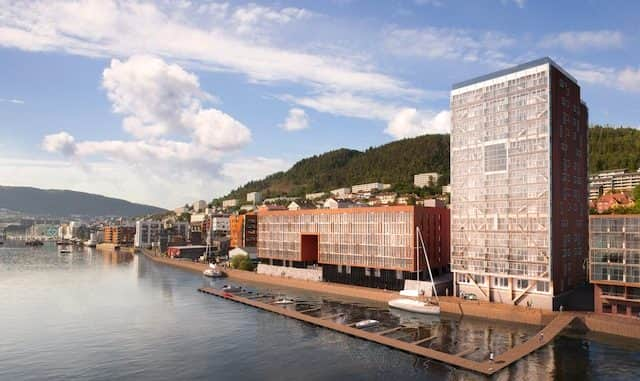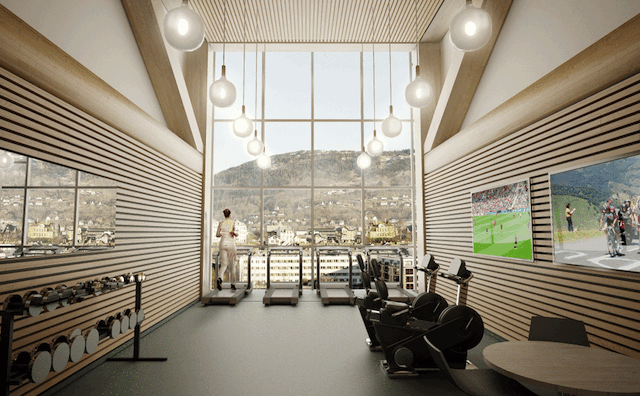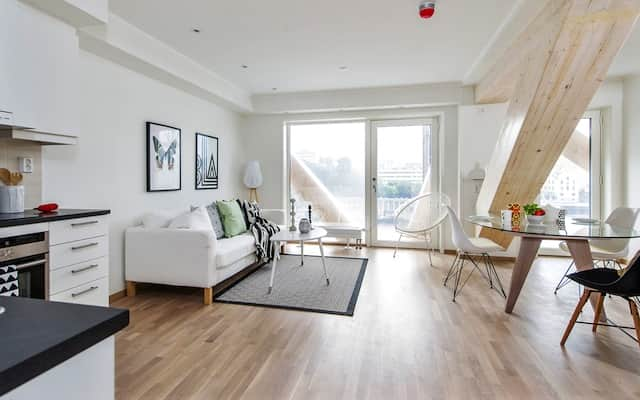
‘Treet’ or ‘The Tree’ is a 14-storey luxury apartment block in central Bergen, Norway, as well as the world’s tallest timber-framed multi-family project at 49 meters. The building is the brainchild of the Bergen and Omegn Building Society (BOB), which aims to be at the forefront of developing homes for the future, with a strong focus on energy consumption, sustainable development and communal outdoor spaces.
 The idea of building a high-rise building by the Puddefjord Bridge was originally suggested by the architect Geir Brekke of Lund & Partnere in 2005 and the project was developed by BOB with significant inputs from Rune B. Abrahamsen of Sweco AS. During the planning of the project, BOB considered various systems for high-rise timber buildings, including the use of solid cross-laminated timber. This system model has been used both in Sweden (Växsjö), London (Murray Grove) and a variety of places in Austria. Designed by architects Artec and engineered by Sweco Norway, the structure comprises a mix of cross-laminated timber and glulam, built on concrete ground floor. The tower consists of a glulam load-bearing structure and prefabricated modular flats, made from engineered timber manufactured by Moelven Limitre using only Norwegian wood. The concept involves the modules being stacked four storeys high, with two platforms (above on the 4th and 9th floors) being anchored to the glulam frame. These platforms are supported and reinforced by 3m-high glulam lattice beams. Another four storeys of modules are then stacked on top of each platform, thereby enabling the developers to build 14 storeys in total.
The idea of building a high-rise building by the Puddefjord Bridge was originally suggested by the architect Geir Brekke of Lund & Partnere in 2005 and the project was developed by BOB with significant inputs from Rune B. Abrahamsen of Sweco AS. During the planning of the project, BOB considered various systems for high-rise timber buildings, including the use of solid cross-laminated timber. This system model has been used both in Sweden (Växsjö), London (Murray Grove) and a variety of places in Austria. Designed by architects Artec and engineered by Sweco Norway, the structure comprises a mix of cross-laminated timber and glulam, built on concrete ground floor. The tower consists of a glulam load-bearing structure and prefabricated modular flats, made from engineered timber manufactured by Moelven Limitre using only Norwegian wood. The concept involves the modules being stacked four storeys high, with two platforms (above on the 4th and 9th floors) being anchored to the glulam frame. These platforms are supported and reinforced by 3m-high glulam lattice beams. Another four storeys of modules are then stacked on top of each platform, thereby enabling the developers to build 14 storeys in total.
 The building offers a total of 62 apartments with 11 one-bedroom apartments (43 sqm) and and 51 two-bedroom apartments (64-66 sqm). The 9th floor includes a communal gym that offers beautiful views over the city and the fjord. In addition, the side facing the sea features an esplanade and marina; while towards Damsgårdsveien, residents will have access to a park and recreation area.
The building offers a total of 62 apartments with 11 one-bedroom apartments (43 sqm) and and 51 two-bedroom apartments (64-66 sqm). The 9th floor includes a communal gym that offers beautiful views over the city and the fjord. In addition, the side facing the sea features an esplanade and marina; while towards Damsgårdsveien, residents will have access to a park and recreation area.
“A key challenge in building a 14-storey high timber building is preventing it from swaying in strong winds. As such, the glulam frame has been reinforced with diagonal glulam braces whilst concrete elements have been installed on the top of the 5th and 10th floors, and on the roof. The concrete elements are not a part of the structural system but have been installed to add weight in order
to reduce movement within the building,” says Ole Herbrand Kleppe, Chief Project Manager at BOB.
According to Kleppe, the building is a pilot project to demonstrate that it is possible to build modern city residences out of materials that meet tomorrow’s standards for sustainability and greenhouse gas emissions, while still achieving a high plot ratio. Using timber instead of non-renewable construction materials represents an important step towards reducing global warming. The role of forests as ‘carbon sinks’, whereby the wood stores carbon as long as the tree is alive or is used in a structure, is expected to become increasingly important in the future.
